Violent conflicts occur around the globe every day. History shows how small disagreements often erupt into larger conflicts that can morph into wars. Wars have long-lasting effects on the environment as well as civilians and the troops who fight in them. This week’s column features books that explore some of those wars and conflicts.
Ages 4–8
Flowers for Sarajevo. John McCutcheon. Ill. Kristy Caldwell. 2017. Peachtree.
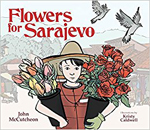 Although Drasko is amazed by his father’s ability to identify the best roses by smell, he is unsure about his generosity, even including giving flowers to a grumpy street vendor. When his father joins the country’s military force, leaving Drasko in charge of their flower stand, the other merchants force him into a less favorable spot in the marketplace. After an explosion kills 22 citizens standing in line waiting to buy bread, the town square becomes deserted. Drasko vows to do his part to restore the city and extends an act of kindness toward Goran, that grumpy merchant. Created in ink, charcoal, graphite pencil, and Adobe Photoshop, the illustrations focus on the city's beauty and resilience. Back matter includes maps of the Balkan region and notes on events in Sarajevo during the Bosnian War, which inspired this story set in 1992. The accompanying CD includes a narration by McCutcheon of his story and Albinoni’s “Adagio,” played by Vedran Smailovic, the cellist in the story.
Although Drasko is amazed by his father’s ability to identify the best roses by smell, he is unsure about his generosity, even including giving flowers to a grumpy street vendor. When his father joins the country’s military force, leaving Drasko in charge of their flower stand, the other merchants force him into a less favorable spot in the marketplace. After an explosion kills 22 citizens standing in line waiting to buy bread, the town square becomes deserted. Drasko vows to do his part to restore the city and extends an act of kindness toward Goran, that grumpy merchant. Created in ink, charcoal, graphite pencil, and Adobe Photoshop, the illustrations focus on the city's beauty and resilience. Back matter includes maps of the Balkan region and notes on events in Sarajevo during the Bosnian War, which inspired this story set in 1992. The accompanying CD includes a narration by McCutcheon of his story and Albinoni’s “Adagio,” played by Vedran Smailovic, the cellist in the story.
Where Will I Live? Rosemary McCarney. 2017. Second Story.
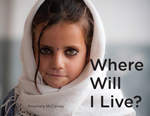 Often, conflict and war within a country or across its borders force its inhabitants to leave their familiar world. Finding a new home isn’t easy. This photo essay contains 24 large portraits of children who are uncertain where they will spend each day and night. After describing the various reasons why and how these children and their families fled their homelands, the author poses a series of questions that these children might ask. Still, humans are surprisingly self-sufficient, as shown by their temporary dwelling places that function as homes—tents, the space beneath a staircase, or even a shelter created by using carpeting for walls and a ceiling. Because the children are from various countries, young readers will recognize that homelessness is a worldwide issue. The photos also portray the resilience of children as they show them indulging in moments of play while facing an uncertain future.
Often, conflict and war within a country or across its borders force its inhabitants to leave their familiar world. Finding a new home isn’t easy. This photo essay contains 24 large portraits of children who are uncertain where they will spend each day and night. After describing the various reasons why and how these children and their families fled their homelands, the author poses a series of questions that these children might ask. Still, humans are surprisingly self-sufficient, as shown by their temporary dwelling places that function as homes—tents, the space beneath a staircase, or even a shelter created by using carpeting for walls and a ceiling. Because the children are from various countries, young readers will recognize that homelessness is a worldwide issue. The photos also portray the resilience of children as they show them indulging in moments of play while facing an uncertain future.
Ages 9–11
Army Brats. Daphne Bendis-Grab. 2017. Scholastic.
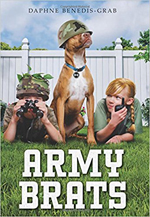 After moving to Fort Patrick with their rescue dog, Cupcake, the Bailey family finds that living on the base is a very different experience from life as civilians. Although Tom, Charlotte, and Rosie are free to move around as they please in the base’s protected environment, the disappearance of several dogs seems to point to possible danger and to a mystery that needs to be solved. In addition, the siblings are dealing with personal problems—Tom is miserable after the class bully calls him Sergeant Wimpy; Charlotte fails to realize that her new friends are interested only in gossiping and denigrating others; and the youngest sibling, Rosie, is challenged by a headstrong need to have her own way all the time. Although the adults in their lives are nearby, they allow the youngsters to solve their problems on their own. The author capably captures life on a military base in the United States for the Bailey family.
After moving to Fort Patrick with their rescue dog, Cupcake, the Bailey family finds that living on the base is a very different experience from life as civilians. Although Tom, Charlotte, and Rosie are free to move around as they please in the base’s protected environment, the disappearance of several dogs seems to point to possible danger and to a mystery that needs to be solved. In addition, the siblings are dealing with personal problems—Tom is miserable after the class bully calls him Sergeant Wimpy; Charlotte fails to realize that her new friends are interested only in gossiping and denigrating others; and the youngest sibling, Rosie, is challenged by a headstrong need to have her own way all the time. Although the adults in their lives are nearby, they allow the youngsters to solve their problems on their own. The author capably captures life on a military base in the United States for the Bailey family.
Ages 12–14
Escaping the Nazis on the Kindertransport. Emma Carlson Berne. 2017. Capstone.
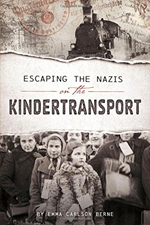 Stories about the Kindertransport, the trains that took children to freedom and out of reach of the Nazis during the Holocaust, are especially compelling. In separate narratives, told in distinct voices, seven very different children, one as young as five years old, relate their experiences of leaving behind everyone and everything that was familiar. The author includes photographs, poems, brief memoirs, and snippets of what the storytellers recollect about those frightening times and their aftermath. She also details the events that led up to each survivor’s departure, pointing out that while some of the children came from wealthy families, others were not. Many of the children never saw their families again. Although it might seem like a small number against the more than one million children who died during the Holocaust, thanks to the kindness of strangers, 10,000 Jewish children survived because of this relocation plan. Readers will ponder the enormous losses associated with this period of history after reading this accessible introduction to the Kindertransport rescues just prior to World War II.
Stories about the Kindertransport, the trains that took children to freedom and out of reach of the Nazis during the Holocaust, are especially compelling. In separate narratives, told in distinct voices, seven very different children, one as young as five years old, relate their experiences of leaving behind everyone and everything that was familiar. The author includes photographs, poems, brief memoirs, and snippets of what the storytellers recollect about those frightening times and their aftermath. She also details the events that led up to each survivor’s departure, pointing out that while some of the children came from wealthy families, others were not. Many of the children never saw their families again. Although it might seem like a small number against the more than one million children who died during the Holocaust, thanks to the kindness of strangers, 10,000 Jewish children survived because of this relocation plan. Readers will ponder the enormous losses associated with this period of history after reading this accessible introduction to the Kindertransport rescues just prior to World War II.
Genevieve’s War. Patricia Reilly Giff. 2017. Holiday House.
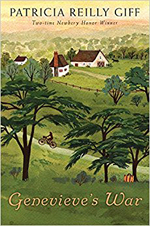 As time for her vacation in Alsace draws to a close, 13-year-old American Genevieve Michel decides to stay in the area and help her elderly grandmother, Mémé. Her impulsive decision is one she will live to regret; it is 1939 and the Germans have begun crossing over the border into France, commandeering food, supplies, and even houses. At first, there is friction between Genevieve and Mémé, but mutual respect slowly develops as they deal with Nazi occupation, hunger, and cold weather and hide a member of the Resistance from the Germans. Giff painstakingly demonstrates the difficulty of knowing who could be trusted during those troubling times. Genevieve grows enormously from her experiences during the four years she spends in Alsace during World War II.
As time for her vacation in Alsace draws to a close, 13-year-old American Genevieve Michel decides to stay in the area and help her elderly grandmother, Mémé. Her impulsive decision is one she will live to regret; it is 1939 and the Germans have begun crossing over the border into France, commandeering food, supplies, and even houses. At first, there is friction between Genevieve and Mémé, but mutual respect slowly develops as they deal with Nazi occupation, hunger, and cold weather and hide a member of the Resistance from the Germans. Giff painstakingly demonstrates the difficulty of knowing who could be trusted during those troubling times. Genevieve grows enormously from her experiences during the four years she spends in Alsace during World War II.
Two Times a Traitor. Karen Bass. 2017. Pajama Press.
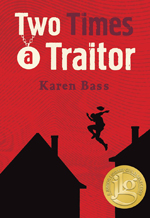 Twelve-year-old Laz Berenger is less than thrilled about visiting Halifax with his family. He’s still angry over the family's recent move to Boston and chafing under his father's rules. While exploring on his own, Laz slips into a tunnel which sends him back in time to 1745. He quickly realizes the importance of the St. Christopher's medal he always wears, but it is no longer in his possession. Laz is forced by English Colonists to spy on the French, with whom they are at war. However, the kindness of Commander Morapain and others in the town of Louisbourg make it hard for Laz to spy on those he considers to be his friends when he knows he will be aiding their enemies. But if he doesn’t betray them, how will he ever get back the medal he needs in order to time travel back home? While it might help readers to have some background on the time period, the author provides enough details to allow them to draw their own conclusions about the battles between the French and the English and Laz’s own personal dilemma.
Twelve-year-old Laz Berenger is less than thrilled about visiting Halifax with his family. He’s still angry over the family's recent move to Boston and chafing under his father's rules. While exploring on his own, Laz slips into a tunnel which sends him back in time to 1745. He quickly realizes the importance of the St. Christopher's medal he always wears, but it is no longer in his possession. Laz is forced by English Colonists to spy on the French, with whom they are at war. However, the kindness of Commander Morapain and others in the town of Louisbourg make it hard for Laz to spy on those he considers to be his friends when he knows he will be aiding their enemies. But if he doesn’t betray them, how will he ever get back the medal he needs in order to time travel back home? While it might help readers to have some background on the time period, the author provides enough details to allow them to draw their own conclusions about the battles between the French and the English and Laz’s own personal dilemma.
Ages 15+
Grendel’s Guide to Love and War. A. E. Kaplan. 2017. Knopf/Random House.
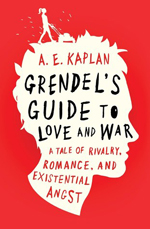 Seventeen-year-old Tom Grendel lives a quiet life with his father in a Southern neighborhood. His own mother died when he was nine, and his father suffers from PTSD as the result of his time spent in the military service. Tom spends his free time mowing yards, weeding gardens, and interviewing his elderly neighbors about their lives. The arrival of a rowdy and rude family that moves into the neighborhood leaves Tom feeling assaulted, mostly because the son, Rex Rothgar, throws parties and blasts loud music into the wee hours. Tom has no choice but to intervene. The battle for a quiet night's sleep is on, and Tom enlists help from some surprising allies. While this is an account of a neighborhood conflict and one boy's determination to fix things, it is also a celebration of love, loyalty, and memory and a story about how hard it is to know someone, much less yourself. Savvy readers will recognize the references to the classic Beowulf that have been woven throughout the narrative.
Seventeen-year-old Tom Grendel lives a quiet life with his father in a Southern neighborhood. His own mother died when he was nine, and his father suffers from PTSD as the result of his time spent in the military service. Tom spends his free time mowing yards, weeding gardens, and interviewing his elderly neighbors about their lives. The arrival of a rowdy and rude family that moves into the neighborhood leaves Tom feeling assaulted, mostly because the son, Rex Rothgar, throws parties and blasts loud music into the wee hours. Tom has no choice but to intervene. The battle for a quiet night's sleep is on, and Tom enlists help from some surprising allies. While this is an account of a neighborhood conflict and one boy's determination to fix things, it is also a celebration of love, loyalty, and memory and a story about how hard it is to know someone, much less yourself. Savvy readers will recognize the references to the classic Beowulf that have been woven throughout the narrative.
To Look a Nazi in the Eye: A Teen’s Account of a War Criminal Trial. Kathy Kacer (with Jordana Lebowitz). 2017. Second Story.
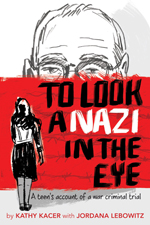 Jordana Lebowitz, a 19-year-old college student, travels from her Canadian home to the town of Luneburg, Germany, to hear testimony from Oskar Groening, a Nazi accused of being complicit in the deaths of more than 300,000 Jews at Auschwitz. Jordana feels conflicted about and sometimes even sympathetic toward Groening as she weighs his words for sincerity and regret. Jordana also listens to the testimony of Holocaust survivors and relatives of those who died in the camps, and she spends time with some of them in between days at the trial. Convinced that it is important for her to bear witness to the trial and for those responsible for all those deaths to be held accountable, Jordana blogs about her experiences. Kacer skillfully juxtaposes Jordana's blog entries, a BBC interview, and other media accounts of the trial. Readers may come away with an understanding that evil wears many faces and that it is unfair to generalize about a particular nation and its citizens. Ultimately, Jordana meets kind-hearted Germans and realizes that simply standing by and doing nothing in the face of evil is the worst crime of all, a lesson readers today might take to heart.
Jordana Lebowitz, a 19-year-old college student, travels from her Canadian home to the town of Luneburg, Germany, to hear testimony from Oskar Groening, a Nazi accused of being complicit in the deaths of more than 300,000 Jews at Auschwitz. Jordana feels conflicted about and sometimes even sympathetic toward Groening as she weighs his words for sincerity and regret. Jordana also listens to the testimony of Holocaust survivors and relatives of those who died in the camps, and she spends time with some of them in between days at the trial. Convinced that it is important for her to bear witness to the trial and for those responsible for all those deaths to be held accountable, Jordana blogs about her experiences. Kacer skillfully juxtaposes Jordana's blog entries, a BBC interview, and other media accounts of the trial. Readers may come away with an understanding that evil wears many faces and that it is unfair to generalize about a particular nation and its citizens. Ultimately, Jordana meets kind-hearted Germans and realizes that simply standing by and doing nothing in the face of evil is the worst crime of all, a lesson readers today might take to heart.
Barbara A. Ward teaches graduate and undergraduate courses in literacy at Washington State University, Pullman. She spent 25 years teaching in the public schools of New Orleans, where she worked with students at every grade level, from kindergarten through high school, as well as several ability levels. She is certified in elementary education, English education, and gifted education. She holds a bachelor's in Communications and a master's in English Education from the University of Tennessee and a PhD in Curriculum and Instruction from the University of New Orleans.
These reviews are submitted by members of the International Literacy Association's Children's Literature and Reading Special Interest Group (CL/R SIG) and are published weekly on Literacy Daily.